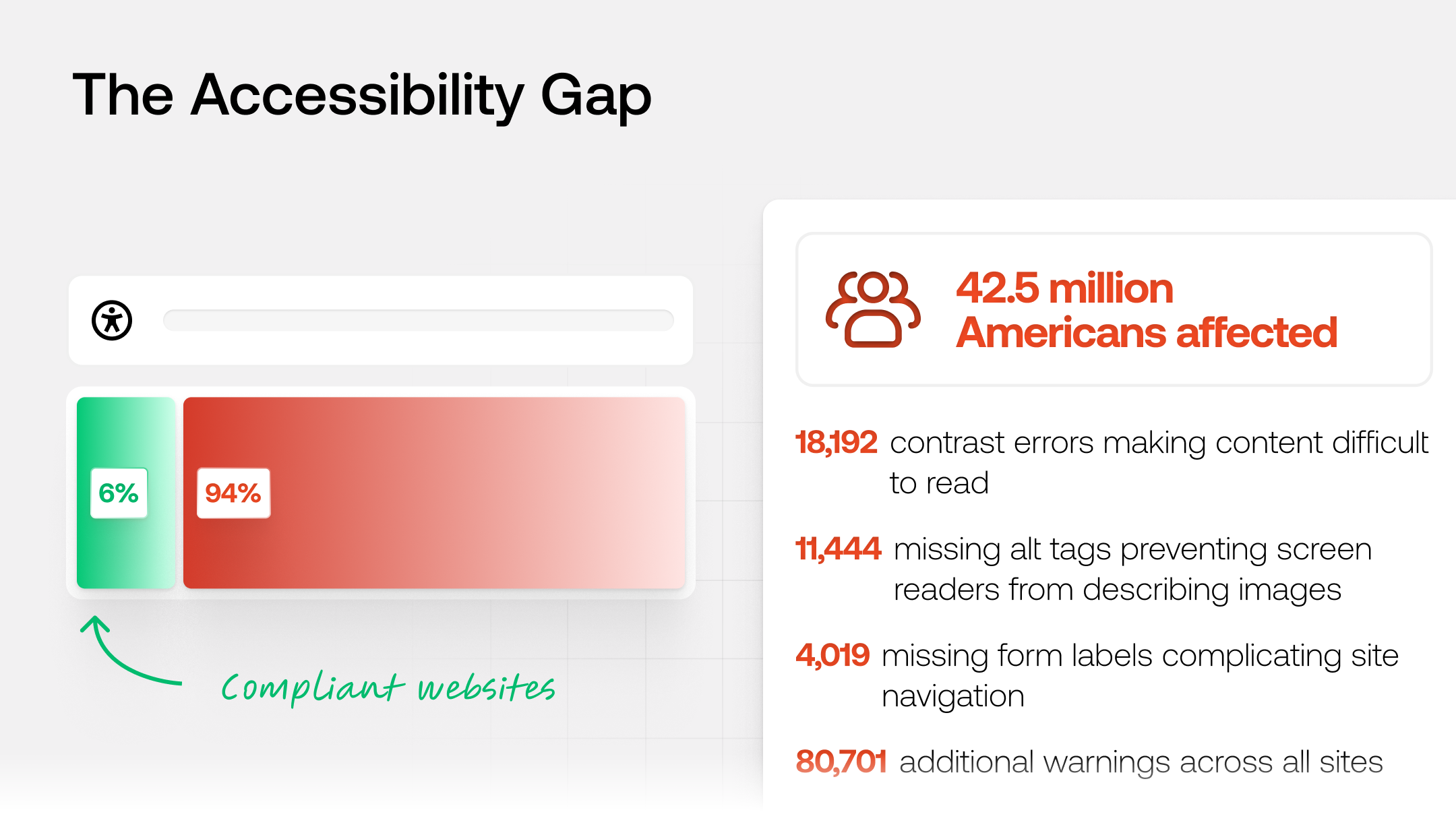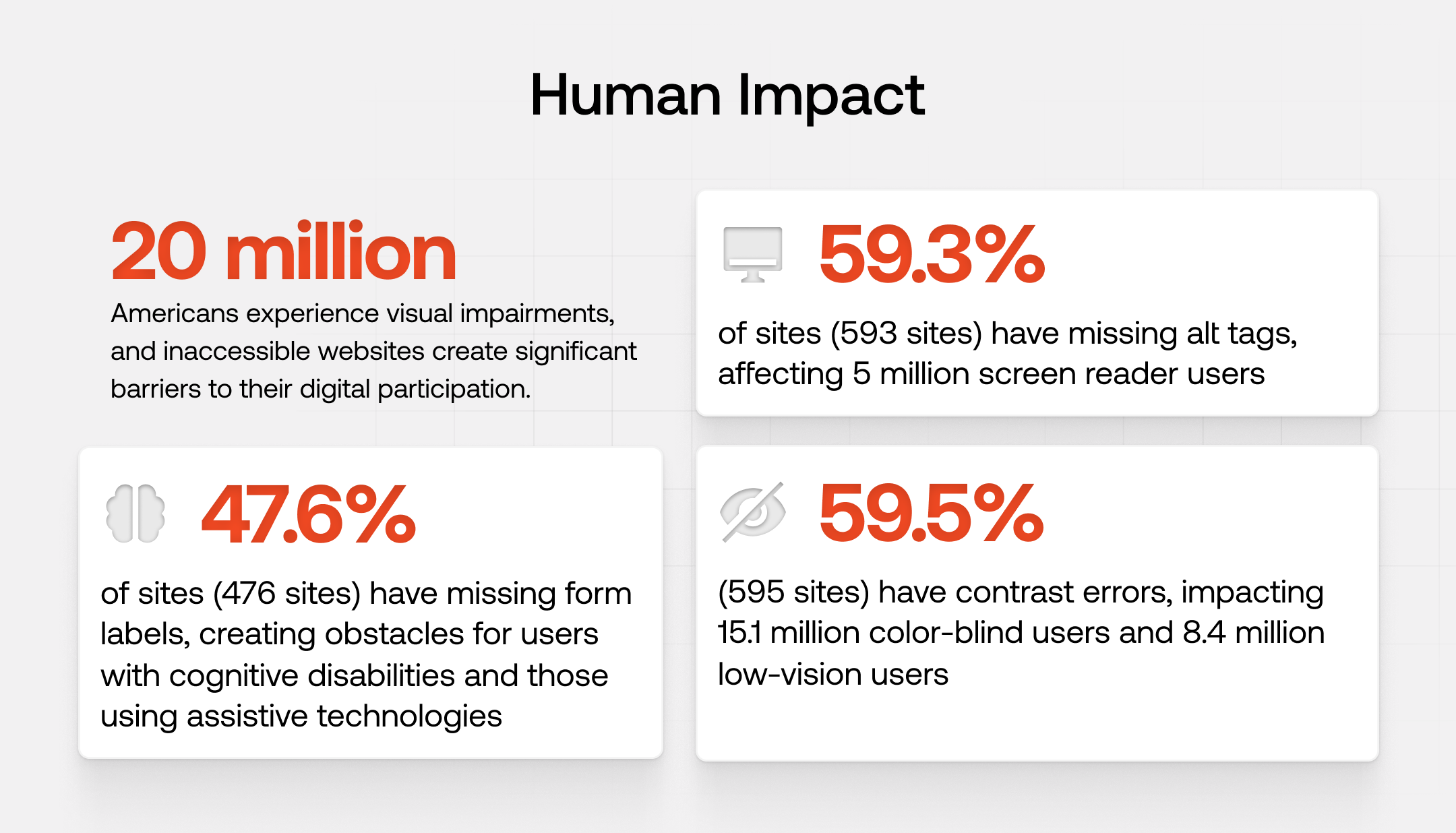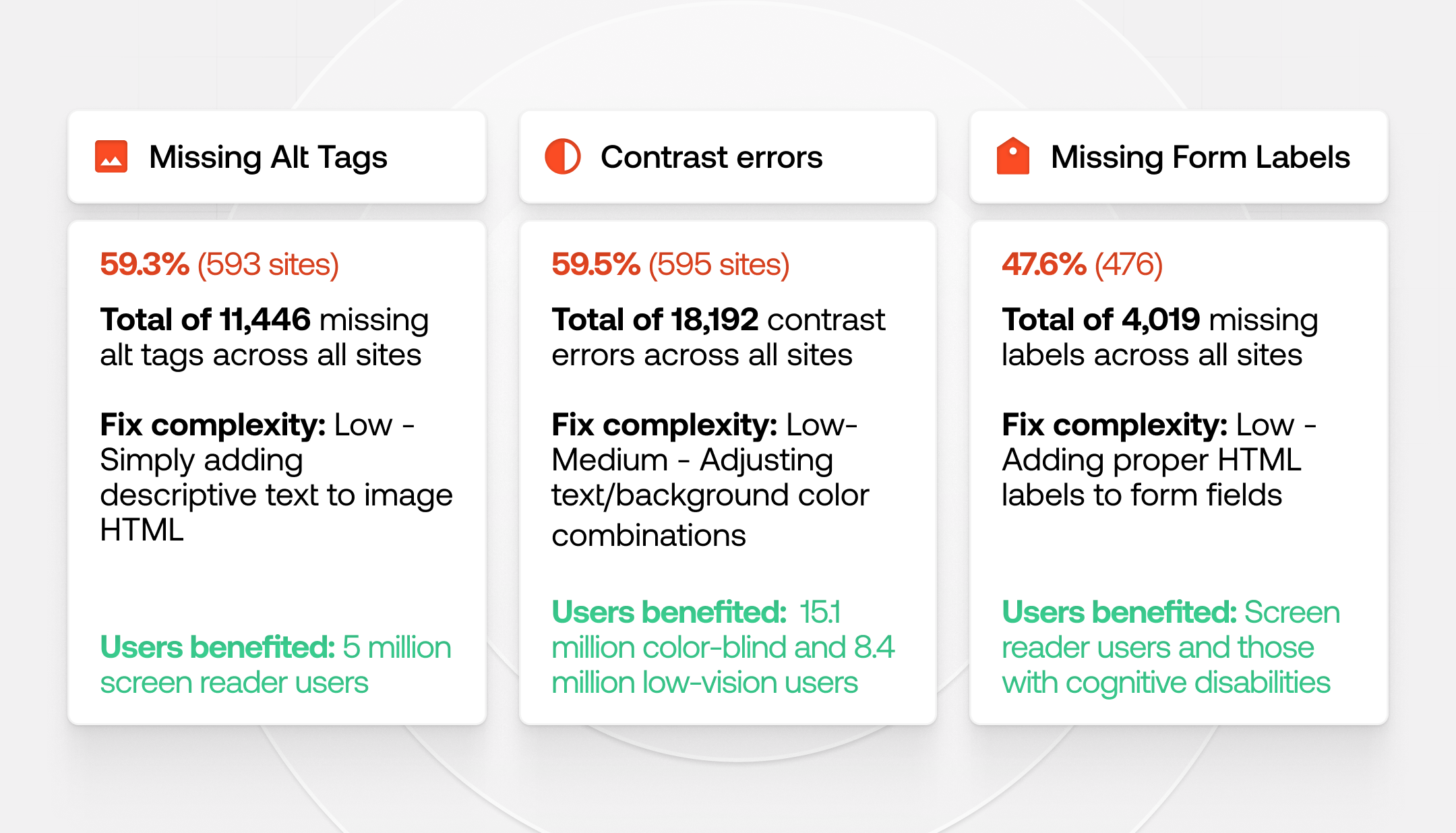35 Years After Americans with Disabilities Act, a Staggering 94% of Top Websites Remain Inaccessible
An alarming 94% of the top websites in the United States are not accessible according to Americans with Disabilities Act (ADA) standards, creating significant barriers for the 42.5 million Americans living with disabilities.

The digital divide isn't just about who has internet access anymore-it's about who can actually use the websites they visit.
An alarming 94% of the top websites in the United States are not accessible according to Americans with Disabilities Act (ADA) standards, creating significant barriers for the 42.5 million Americans living with disabilities.
According to our comprehensive analysis of the top 1,000 most-visited US websites, only 61 sites (a mere 6.1%) are fully ADA-compliant with zero critical errors. The remaining sites collectively contain a staggering 27,096 critical accessibility errors.
This widespread non-compliance isn't just a moral failure-it represents up to $490 billion in potential lost business annually and exposes companies to over $23.4 million in potential litigation risks.

The analysis reveals that even the most popular websites fall short in fundamental accessibility requirements:
- 18,192 contrast errors making content difficult to read
- 11,444 missing alt tags preventing screen readers from describing images
- 4,019 missing form labels complicating site navigation
- 80,701 additional warnings across all sites
To put these numbers in perspective, the average top-visited website contains 27 critical accessibility errors that create significant barriers for users with disabilities. These aren't merely technical violations—they represent real obstacles encountered daily by millions of Americans.
If physical stores had equivalent accessibility barriers (missing ramps, unusable doorways, unreadable signage), there would be immediate public outcry and regulatory action. Yet in the digital realm, these widespread failures have become normalized despite affecting considerably more people each day than their physical counterparts.
With nearly 20 million Americans experiencing visual impairments alone, these accessibility failures aren't just technical oversights-they represent real barriers to information, services, and opportunities in an increasingly digital world.
Why We Conducted This Study
Website accessibility has become increasingly critical as our daily lives have shifted online. From shopping and banking to healthcare and education, digital access is no longer optional—it's essential for full participation in society.
The legal landscape continues to evolve, with courts and regulatory bodies increasingly interpreting the Americans with Disabilities Act to include websites as places of public accommodation. This has led to a rising tide of accessibility lawsuits against companies with non-compliant websites.
At the same time, businesses are beginning to recognize the economic opportunity represented by the millions of Americans with disabilities. With their substantial purchasing power estimated at $490 billion annually, companies with inaccessible websites are effectively shutting out a significant consumer market.
This convergence of legal pressure and economic incentive creates an urgent need for businesses to address accessibility barriers on their websites.
The Data
Our analysis of 1,000 top US websites reveals a troubling accessibility landscape with widespread compliance failures across industries.
Overall Accessibility Landscape

Only 61 out of 1,000 analyzed websites (6.1%) are fully ADA-compliant with zero critical errors. The remaining sites collectively harbor:
- 27,096 critical errors
- 18,192 contrast errors
- 11,446 missing alt tags
- 4,019 missing form labels
- 80,701 warnings
Industry Performance
The travel industry emerges as the worst performer, averaging 136 critical errors per website—more than triple the errors found in news sites (44), the second-worst category. By contrast, government websites lead in compliance with just 7 errors per site on average.
The top five most accessible industries:
- Government (7 errors per site)
- Health (11 errors per site)
- Education (12 errors per site)
- Food & Drink (16 errors per site)
- Entertainment (23 errors per site)
The five least accessible industries:
- Travel (136 errors per site)
- News (44 errors per site)
- Gaming (36 errors per site)
- eCommerce (35 errors per site)
- Media (30 errors per site)

Different industries struggle with specific accessibility issues:
- Gaming sites have almost double the average contrast errors (35 vs 18)
- Travel websites have triple the average missing alt tags (35 vs 11)
- Finance, gaming, and news sites have the most missing ARIA labels (836, 828, and 826 respectively)
- Food & drink websites have 4.5x more missing form labels than average (18 vs 4)

Technology Platform Analysis
Website building platforms show significant variance in accessibility performance:
- WordPress sites average 40 critical errors
- Webflow sites average 37 critical errors
- Shopify sites perform better with 20 critical errors
- Hubspot sites average 13 critical errors
- Drupal sites average just 11 critical errors

Implications
Human Impact
Nearly 20 million Americans experience visual impairments, and inaccessible websites create significant barriers to their digital participation.
Our analysis reveals the scope of this exclusion:
- 59.3% of sites (593 sites) have missing alt tags, affecting 5 million screen reader users
- 59.5% of sites (595 sites) have contrast errors, impacting 15.1 million color-blind users and 8.4 million low-vision users
- 47.6% of sites (476 sites) have missing form labels, creating obstacles for users with cognitive disabilities and those using assistive technologies
The error distribution shows 47.7% of sites have 10 or more critical errors, while 11.9% have 50 or more critical errors—creating environments that are virtually unusable for many visitors with disabilities.

Economic Consequences
This accessibility gap represents substantial financial implications:
- Companies collectively risk losing up to $490 billion annually from customers with disabilities
- The average ADA website lawsuit costs approximately $25,000
- With 935 non-compliant websites in our analysis, the potential litigation exposure exceeds $23.4 million
- Industries with the highest legal risk include: Music (36.4% high-risk sites), Gaming (46.7%), Sports (20%), Technology (29.6%), and Entertainment (29.2%)
The Quick-Fix Opportunity
Our analysis reveals encouraging news: many accessibility issues are straightforward to correct:
The Three Easiest Fixes with Biggest Impact
- Missing Alt Tags
- Present on 59.3% of sites (593 sites)
- Total of 11,446 missing alt tags across all sites
- Fix complexity: Low - Simply adding descriptive text to image HTML
- Users benefited: 5 million screen reader users
- Contrast Errors
- Present on 59.5% of sites (595 sites)
- Total of 18,192 contrast errors across all sites
- Fix complexity: Low-Medium - Adjusting text/background color combinations
- Users benefited: 15.1 million color-blind and 8.4 million low-vision users
- Missing Form Labels
- Present on 47.6% of sites (476 sites)
- Total of 4,019 missing labels across all sites
- Fix complexity: Low - Adding proper HTML labels to form fields
- Users benefited: Screen reader users and those with cognitive disabilities

Looking Ahead
Our analysis reveals both an urgent accessibility crisis and an unprecedented opportunity for improvement. With 94% of top websites failing accessibility standards, there's a clear imperative for businesses to address these issues-both to serve users with disabilities and to mitigate legal risks.
The three easiest fixes identified-adding alt tags, fixing contrast errors, and properly labeling forms—could dramatically improve accessibility across nearly 60% of sites with minimal investment.
The path forward requires balancing technical implementation with genuine inclusion. While complete WCAG compliance may seem daunting for many organizations, incremental improvements can make an immediate difference for millions of Americans with disabilities.
As digital experiences become increasingly central to daily life, creating accessible websites isn't just about compliance—it's about ensuring equal access to the digital world for everyone.
Methodology
We analyzed a comprehensive dataset of 996 of the top 1,000 most-visited websites in the United States to evaluate their compliance with accessibility standards.
This extensive sample provides a robust foundation for our findings on the state of web accessibility across various industries and platforms.
Data Collection Process
Our analysis employed a multi-faceted approach to capture various accessibility metrics:
- Automated Testing
- We utilized APIfy to systematically scan each website for critical errors, contrast errors, and warnings according to established Web Content Accessibility Guidelines (WCAG) 2.1.
- Custom Python scripts were developed to identify and quantify specific accessibility issues, including missing alt tags and form fields.
- Website Selection
- The websites included in our analysis were selected based on traffic volume and keyword rankings, sourced from authoritative SEO data providers.
- The final dataset represents a cross-section of the most influential websites across different industries and various technology platforms.
Data Analysis
The collected data was systematically organized and analyzed to identify:
- Overall accessibility compliance rates
- Industry-specific accessibility performance
- Common accessibility issues across different website types
- Relationships between website technology platforms and accessibility performance
Critical errors were identified as WCAG violations that prevent users with disabilities from accessing essential content or functionality, such as missing image descriptions for screen readers or form elements without proper labels.
Limitations
As with any technical analysis, there are certain limitations to consider:
- Some industry categories contain a relatively small number of websites, which may affect the representativeness of findings for those specific sectors.
- The analysis focused on homepage accessibility, which may not reflect the accessibility of deeper pages within each website.
- Our target was to analyze the top 1,000 US websites, but data was only obtainable for 996 sites, creating a minor gap in the dataset.
- Automated testing can identify many technical accessibility issues but cannot fully assess the user experience of people with disabilities.
Andrew Smith is the co-founder of Tenscope.com, a UX and marketing design agency helping SaaS companies build accessible, high-converting digital products.









